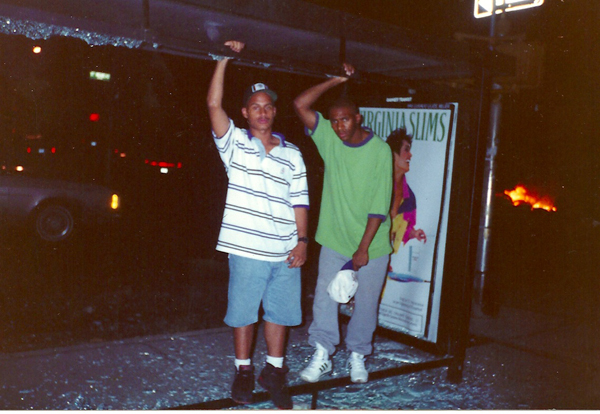By John Paul Infante (@infantejp)
I’m guilty of having judged more than one book by its cover. Angie Cruz’ Soledad has an indigenous looking woman with hair over her bare shoulders on the cover. Nelly Rosario’s Song of the Water Saint’s has bare feet, something like the lower half of Cruz’s book. Book covers are first impression and after seeing these two I thought, cliché. But it was not until experiencing these novels that I understood what these Dominican writer’s narratives were all about. In the same way a novel’s cover says very little about its pages, there is only so much an author’s ethnicity can tell you about their writing.
Last Saturday afternoon was the first Led Black Book Club meeting at APT. 78. Led Black moderated as Jon Michaud read from his debut, When Tito Loved Clara. The story takes place in the Washington Heights-Inwood area, among other locations, and has Dominicans as protagonists.
I attended the event without having read the novel but had seen the book’s cover, a railroad parallel to a river going under a bridge, on jonmichaud.com. From the site I learned Michaud was born in Washington DC. Immediately, I feared Michaud’s endeavor would be misconstrued as appropriation, mirroring the negative aspects of the gentrification taking place in the neighborhood he writes about. So like book covers in the past, the author’s background tempted me to form preconceived notions.
Jon Michaud’s novel When Tito Loved Clara is about disparate and related themes, like nostalgic love, marriage, immigrants, first generationers, assimilation, social mobility and the American Dream. The title character, Clara, arrived to the US at the age of nine and after growing up in Inwood, Manhattan “moves on up” to the suburbs of New Jersey. Clara leaves behind her first love, Tito, who stays living in the old neighborhood and in that past where both of them were lovers.
After Michaud read excerpts from his novel, the Q&A began. The questions were varied, ranging from specifics like an abortion in the story to the overall narrative structure like plot development. Led Black attributed Michaud’s appreciation of Dominican culture to his childhood. Michaud is the son of an U.S. diplomat and grew up in Tehran, Iran, Bombay, India, Bethesda, Maryland, Belfast, and Northern Ireland.
Those in the audience who had read the novel, many of them Dominicans, were amazed at the author’s exactitude, pointing out his spot-on depiction of the relationship between Dominican mother and son. Evidence of the complexity of Michaud’s characters is the time spent psychoanalyzing Tito and his romantic preoccupation with Clara, which to some bordered on the delusional.
One reader compared the novel to F. Scott Fitzgerald’s The Great Gatsby, leading Michaud to describe Tito’s character, as a “Jay Gatz without means.” When another person brought up William Shakespeare’s Romeo and Juliet, Michaud said his goal was to explore a story where young lovers were kept apart, but unlike the play, had survived with the memory of their affair.
After reading the novel, I can’t help but think about James Joyce’s The Dubliners and Sherwood Anderson’s Winesberg, Ohio because of the way Michaud uses place to create form. The main difference from Michaud’s novel and these classics is his attention and skill with plot. This book is not genre fiction but a literary page-turner.
I asked the author if the constant changing landscape of Washington Heights and Inwood influenced the development of the novel. Michaud said that although these realities are in the story they are not central, but in the background, because he leaves these particulars to nonfiction writers.
It is easy to dismiss those authors whose ethnicity is different from the characters they write about. Jon Michaud was not born in the Dominican Republic nor were his parents, and yet this is what makes When Tito Loved Clara worth reading. Michaud has taken a risk in writing about these individuals. These fictional Dominicans could have easily become cartoon characters in the hands of a less skillful writer. Instead, you had Dominicans from the Washington Heights and Inwood area talking about Tito and Clara as if they were family members and neighbors.
Some readings are great because they help you better understand a book you’ve read and others are great because they introduce you to an author and their work, which was my experience at the first Led Black Book Club meeting. After having read When Tito Loved Clara I consider it a must-read and therefore recommend it with the same enthusiasm I invite you to the next Led Black Book Club meeting.
Related:
The Led Black Book Club Ft Jon Michaud – The Recap
The Led Black Book Club ft Robb Todd – The Recap
The Led Black Book Club ft Robb Todd In Pictures
We invite you to subscribe to the Uptown Love newsletter, like our Facebook page and follow us on Twitter, or e-mail us at [email protected].



Elizabeth
June 14, 2011 at 12:13 pmI’m interested in reading this book now!
blanca
June 15, 2011 at 9:44 amwhere can this book be purchased???
uptownco
June 15, 2011 at 10:00 amHey Blanca – I have a few copies left. If you live in the Uptown area I can personally drop one off, send me an email: [email protected] or you can purchase at your favorite bookseller. Also, see below for more options.
Purchase online: http://amzn.to/lclT41
Kindle Edition: http://amzn.to/mNdPQ1
Led